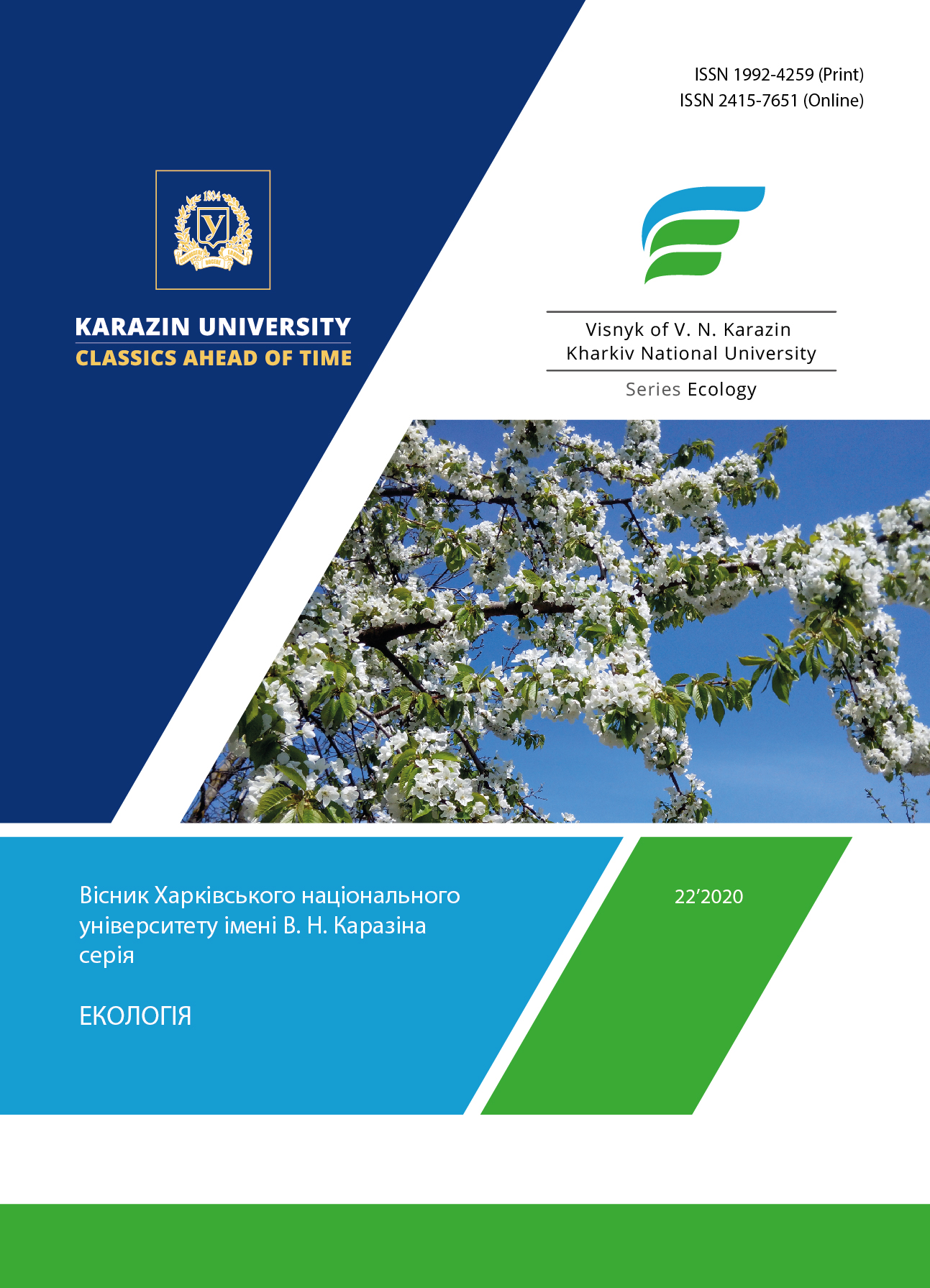Екологічна безпека та якість рослинних продуктів харчування (на прикладі винограду)
Ключові слова:
виноград, виноградні кісточки, ґрунт, важкі метали, нітратиАнотація
Актуальність. Вирощування винограду в останні роки стає дедалі популярним ремеслом, особливо серед звичайних фермерів. Виноград унікальний за своїм складом продукт, до того ж надзвичайно корисний. Тому визначення його якості та екологічної безпеки щодо споживання населенням є досить актуальним.
Мета. Визначення екологічної безпеки та якості рослинних продуктів харчування (на прикладі винограду), вирощеного у смт. Високий Харківського району Харківської області.
Методи. Польові, методи атомно-абсорбційної спектрометрії з використанням спектрометра МГА-915МД, статистичні, аналітичні, порівняльно-географічні.
Результати. Досліджено ягоди та кісточки 10 сортів винограду, а також зразки ґрунту, як середовища місцезростання винограду. Визначено концентрації важких металів (Zn, Cu, Cd, Cr, Pb) і нітратів у плодовій частині винограду. Встановлено, що у ягодах та кісточках у жодного із сортів винограду концентрації важких металів не перевищують нормативних показників. У зразках ґрунту перевищень ГДК за важкими металами також не визначено. Спостерігається у виноградних ягодах перевищення нормативних показників за нітратами у середньому у 1,5 рази. Показники коефіцієнту біогеохімічної рухливості за важкими металами вказують на те, що найбільше накопичуються у плодовій частині винограду Cu та Cr.
Висновки. Концентрація важких металів у плодовій частині та у кісточках всіх сортів винограду, а також у ґрунтах не перевищує нормативів. Незначні перевищення нормативів за нітратами визначені у плодовій частині винограду. В цілому виноград може використовуватися населенням як харчовий продукт.
Посилання
Dyman, T. M., Baranovsky, M. M. & Bilyavsky, G. M. (2006). Ecotrophology. The basics of environmental-ly friendly baking. T. M. Dyman (Ed.). Kyiv: Libra (in Ukranian).
Nekos, A. N. & Malchuk, O. V. (2015). Features of concentration of heavy metals in grapes and products of its processing. Visnyk of V. N. Karazin Kharkiv National University Series “Ecology”, (1147), 106-113. Re-trieved from https://periodicals.karazin.ua/ecology/article/view/3928 (in Ukranian).
Amirdjanov, A. G. (1980). Solar radiation and vineyard productivity. Leningrad: Gidrometeoizdat (in Russian).
Nikiforova, L. T., Spektor, Ya. S. & Podgornaya, S. V. (1988). Handbook of viticulture. Kyiv: Urozhay (in Russian).
Zhemerov, O. O. & Shulika, B.O. (2010). Agroclimatic conditions of growing grapes in the area of the village Visokyi for 1994-2010 r. Visnyk of V. N. Karazin Kharkiv National University, Series "Geology. Geography. Ecology”, (924), 101-110 (in Ukranian).
Shulika, B. O. (2013). The phases of grapes’ growth in the context of weather types in village Vysokyi. Problems of Continuous Geographic Education and Cartography, (18), 176-181. Retrieved from https://periodicals.karazin.ua/pbgok/article/view/4193 (in Ukranian).
Ilchuk, M. M. & Dmytruk, M. I. (2019). Development of grape production in Ukraine. APK economy, (1), 18 (in Ukranian).
Kucherenko V. (2020). Viticulture and winemaking today. Vector motion and industry development. Re-trieved from https://www.syngenta.ua/news/novini-kompaniyi/vinogradarstvo-ta-vinorobstvo-sogodni-vektor-ruhu-ta-rozvitku-galuzi (in Ukranian).
Avidzba A. M. (2020). Program for the Development of Viticulture and Viticulture in Ukraine in 2025. Re-trieved from http://www.info-library.com.ua/libs/stattya/2773-programma-razvitija-vinogradarstva-i-vinodelija-v-ukraine-do-2025-g.html (in Russian).
Useful properties of grape bones for the person. (2020). Retrieved from http://prodgid.ru/poleznye-svoystva/nuts-and-seeds/kostochki-vinograda (in Russian).
Nekos, A. N. (2009). Problems of ecological safety of food of plant origin. Man and the environment. Issues of neoecology, (12), 56-62 (in Ukranian).
Nekos, A. N. & Kholin, Yu. V. (2015). Trophogeography: theory and practice. Kharkiv: V.N. Karazin KhNU (in Ukranian).
Dubinina, A. A., Maliuk, L. P. & Seliutina, H. A. (2007). Toxicity in grub products and the following meth-ods. Kyiv: VD "Profesional" (in Ukranian).
Mykytyuk, O. M, Boychuk, Yu. D. & Ionov, I. A. (2007). Ecological safety of human nutrition. Kharkiv: KhNPU (in Ukranian).
DSTU 4287:2004. (2005). Soil quality. Kyiv: State Consumer Standard of Ukraine (in Ukranian).
DSTU 7080:2009. (2010). Soil quality. Conducting field experiments. Basic requirements. Kyiv: State Con-sumer Standard of Ukraine (in Ukranian).
DSTU ISO 11464:2007. (2012). Soil quality. Pre-treatment of samples for physic-chemical analysis. Kyiv: State Consumer Standard of Ukraine (in Ukranian).
Maximum permissible concentrations of heavy metals and arsenic in food raw materials and foodstuffs. (1986). Moscow: Minzdrav SSSR (in Russian).
Hygienic standards GN 2.1.7.2041-06. (2006). Maximum permissible concentrations of chemicals in the soil. Moscow: Ministry of Health of Russia (in Russian).
Perelman A. I. & Kasimov N. S. (1999). Geochemistry of the landscape. Moscow: Moscow State. Univ. (in Russian).
##submission.downloads##
Номер
Розділ
Ліцензія
Автори, які публікуються у цьому журналі, погоджуються з наступними умовами:
- Автори залишають за собою право на авторство своєї роботи та передають журналу право першої публікації цієї роботи на умовах ліцензії Creative Commons Attribution License 4.0 International (CC BY 4.0), котра дозволяє іншим особам вільно розповсюджувати опубліковану роботу з обов'язковим посиланням на авторів оригінальної роботи та першу публікацію роботи у цьому журналі.
- Автори мають право укладати самостійні додаткові угоди щодо неексклюзивного розповсюдження роботи у тому вигляді, в якому вона була опублікована цим журналом (наприклад, розміщувати роботу в електронному сховищі установи або публікувати у складі монографії), за умови збереження посилання на першу публікацію роботи у цьому журналі.
- Політика журналу дозволяє і заохочує розміщення авторами в мережі Інтернет (наприклад, у сховищах установ або на особистих веб-сайтах) рукопису роботи, як до подання цього рукопису до редакції, так і під час його редакційного опрацювання, оскільки це сприяє виникненню продуктивної наукової дискусії та позитивно позначається на оперативності та динаміці цитування опублікованої роботи (див. The Effect of Open Access).

